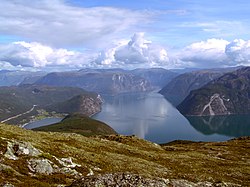Kaupanger | |
|---|---|
Village | |
 View of Kaupanger (left) from Storhaugen mountain | |
| Coordinates: 61°11′04″N 07°14′32″E / 61.18444°N 7.24222°E | |
| Country | Norway |
| Region | Western Norway |
| County | Vestland |
| District | Sogn |
| Municipality | Sogndal |
| Area | |
| • Total | 1.1 km2 (0.4 sq mi) |
| Elevation | 1 m (3 ft) |
| Population (2013)[1] | |
| • Total | 1,012 |
| • Density | 920/km2 (2,400/sq mi) |
| Time zone | UTC+01:00 (CET) |
| • Summer (DST) | UTC+02:00 (CEST) |
| Post Code | 6854 Kaupanger |
Kaupanger is a village situated along the northern shore of the Sognefjorden in the municipality of Sogndal in Vestland county, Norway. It sits along the Norwegian National Road 5, about 12 kilometres (7.5 mi) southeast of the municipal centre of Sogndalsfjøra and about 8 kilometres (5.0 mi) northeast of the Sogndal Airport, Haukåsen. Kaupanger IL is a sports club located in Kaupanger.
The 1.1-square-kilometre (270-acre) village has a population (2019) of 1,012 and a population density of 920 inhabitants per square kilometre (2,400/sq mi).[1]
History
[edit]Kaupanger originated as a settlement during the Viking Age. Earlier, Kaupanger was known as Tingstad. Kaupang is an Old Norse term for a trading or market place so the village's name is composed of kaup- (buy) and angr (fjord, harbor), hence "buy harbor", similar to the literal translation of Copenhagen. The Kaupanger Stave Church is believed to have been built in the 12th century and it is still in existence in this village.[3]
References
[edit]- ^ a b c Statistisk sentralbyrå (1 January 2019). "Urban settlements. Population and area, by municipality".
- ^ "Kaupanger" (in Norwegian). yr.no. Retrieved 2010-09-04.
- ^ Store norske leksikon. "Kaupanger. – tettsted" (in Norwegian). Retrieved 2010-09-04.


Well, that’s interesting to know that Psilotum nudum are known as whisk ferns. Psilotum nudum is the commoner species of the two. While the P. flaccidum is a rare species and is found in the tropical islands. Both the species are usually epiphytic in habit and grow upon tree ferns. These species may also be terrestrial and grow in humus or in the crevices of the rocks.
View the detailed Guide of Psilotum nudum: Detailed Study Of Psilotum Nudum (Whisk Fern), Classification, Anatomy, Reproduction